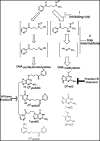Kava blocks 4-(methylnitrosamino)-1-(3-pyridyl)-1-butanone-induced lung tumorigenesis in association with reducing O6-methylguanine DNA adduct in A/J mice
- PMID: 24403291
- PMCID: PMC3888881
- DOI: 10.1158/1940-6207.CAPR-13-0301
Kava blocks 4-(methylnitrosamino)-1-(3-pyridyl)-1-butanone-induced lung tumorigenesis in association with reducing O6-methylguanine DNA adduct in A/J mice
Abstract
We previously reported the chemopreventive potential of kava against 4-(methylnitrosamino)-1-(3-pyridyl)-1-butanone (NNK)- and benzo(a)pyrene (BaP)-induced lung tumorigenesis in A/J mice during the initiation and postinitiation stages. In this study, we investigated the tumorigenesis-stage specificity of kava, the potential active compounds, and the underlying mechanisms in NNK-induced lung tumorigenesis in A/J mice. In the first experiment, NNK-treated mice were given diets containing kava at a dose of 5 mg/g of diet during different periods. Kava treatments covering the initiation stage reduced the multiplicity of lung adenomas by approximately 99%. A minimum effective dose is yet to be defined because kava at two lower dosages (2.5 and 1.25 mg/g of diet) were equally effective as 5 mg/g of diet in completely inhibiting lung adenoma formation. Daily gavage of kava (one before, during, and after NNK treatment) completely blocked lung adenoma formation as well. Kavalactone-enriched fraction B fully recapitulated kava's chemopreventive efficacy, whereas kavalactone-free fractions A and C were much less effective. Mechanistically, kava and fraction B reduced NNK-induced DNA damage in lung tissues with a unique and preferential reduction in O(6)-methylguanine (O(6)-mG), the highly tumorigenic DNA damage by NNK, correlating and predictive of efficacy on blocking lung adenoma formation. Taken together, these results demonstrate the outstanding efficacy of kava in preventing NNK-induced lung tumorigenesis in A/J mice with high selectivity for the initiation stage in association with the reduction of O(6)-mG adduct in DNA. They also establish the knowledge basis for the identification of the active compound(s) in kava.
©2013 AACR.
Figures

 ; NNK + kava:
; NNK + kava: ). B. Relative amount of DNA adducts in NNK + kava treatment group at different time points after NNK treatment (the amount with kava treatment normalized to that induced by NNK alone at the same time point). C. The amount of DNA adducts with different kava fraction treatment 24 h after NNK treatment. D. Relative amount of DNA adducts by different kava fractions normalized to that induced by NNK alone at the 24 h time point.
). B. Relative amount of DNA adducts in NNK + kava treatment group at different time points after NNK treatment (the amount with kava treatment normalized to that induced by NNK alone at the same time point). C. The amount of DNA adducts with different kava fraction treatment 24 h after NNK treatment. D. Relative amount of DNA adducts by different kava fractions normalized to that induced by NNK alone at the 24 h time point.
Similar articles
-
Dihydromethysticin from kava blocks tobacco carcinogen 4-(methylnitrosamino)-1-(3-pyridyl)-1-butanone-induced lung tumorigenesis and differentially reduces DNA damage in A/J mice.Carcinogenesis. 2014 Oct;35(10):2365-72. doi: 10.1093/carcin/bgu149. Epub 2014 Jul 22. Carcinogenesis. 2014. PMID: 25053626 Free PMC article.
-
Lung tumor induction in A/J mice by the tobacco smoke carcinogens 4-(methylnitrosamino)-1-(3-pyridyl)-1-butanone and benzo[a]pyrene: a potentially useful model for evaluation of chemopreventive agents.Carcinogenesis. 1994 Dec;15(12):2721-5. doi: 10.1093/carcin/15.12.2721. Carcinogenesis. 1994. PMID: 8001227
-
Chemopreventive effect of kava on 4-(methylnitrosamino)-1-(3-pyridyl)-1-butanone plus benzo[a]pyrene-induced lung tumorigenesis in A/J mice.Cancer Prev Res (Phila). 2008 Nov;1(6):430-8. doi: 10.1158/1940-6207.CAPR-08-0027. Cancer Prev Res (Phila). 2008. PMID: 19138990 Free PMC article.
-
Chemoprevention by isothiocyanates.J Cell Biochem Suppl. 1995;22:195-209. doi: 10.1002/jcb.240590825. J Cell Biochem Suppl. 1995. PMID: 8538199 Review.
-
The prevention of lung cancer induced by a tobacco-specific carcinogen in rodents by green and black Tea.Proc Soc Exp Biol Med. 1999 Apr;220(4):244-8. doi: 10.1046/j.1525-1373.1999.d01-42.x. Proc Soc Exp Biol Med. 1999. PMID: 10202397 Review.
Cited by
-
Dietary Phytochemicals as Potential Chemopreventive Agents against Tobacco-Induced Lung Carcinogenesis.Nutrients. 2023 Jan 17;15(3):491. doi: 10.3390/nu15030491. Nutrients. 2023. PMID: 36771198 Free PMC article. Review.
-
Reducing tobacco-associated lung cancer risk: a study protocol for a randomized clinical trial of AB-free kava.Trials. 2023 Jan 18;24(1):36. doi: 10.1186/s13063-023-07081-x. Trials. 2023. PMID: 36653872 Free PMC article.
-
Kava as a Clinical Nutrient: Promises and Challenges.Nutrients. 2020 Oct 5;12(10):3044. doi: 10.3390/nu12103044. Nutrients. 2020. PMID: 33027883 Free PMC article. Review.
-
Flavokavains A- and B-Free Kava Enhances Resilience against the Adverse Health Effects of Tobacco Smoke in Mice.ACS Pharmacol Transl Sci. 2024 Oct 2;7(11):3502-3517. doi: 10.1021/acsptsci.4c00415. eCollection 2024 Nov 8. ACS Pharmacol Transl Sci. 2024. PMID: 39539272
-
Kavalactone Kawain Impedes Urothelial Tumorigenesis in UPII-Mutant Ha-Ras Mice via Inhibition of mTOR Signaling and Alteration of Cancer Metabolism.Molecules. 2023 Feb 9;28(4):1666. doi: 10.3390/molecules28041666. Molecules. 2023. PMID: 36838656 Free PMC article.
References
-
- Siegel R, Naishadham D, Jemal A. Cancer statistics, 2012. CA Cancer J Clin. 2012;62:10–29. - PubMed
-
- Siegel R, Naishadham D, Jemal A. Cancer statistics, 2013. CA Cancer J Clin. 2013;63:11–30. - PubMed
-
- Giovino GA, Mirza SA, Samet JM, Gupta PC, Jarvis MJ, Bhala N, et al. Tobacco use in 3 billion individuals from 16 countries: an analysis of nationally representative cross-sectional household surveys. Lancet. 2012;380:668–79. - PubMed
-
- Giovino GA. The tobacco epidemic in the United States. Am J Prev Med. 2007;33:S318–26. - PubMed
Publication types
MeSH terms
Substances
Grants and funding
LinkOut - more resources
Full Text Sources
Other Literature Sources
Medical

